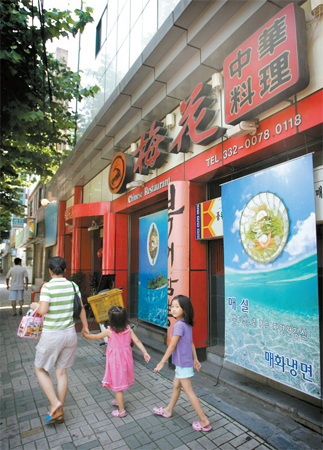Not quite Chinatown, but the flavor is still there

Customers dine at a Chinese restaurant in Yeonnam-dong last Friday.
But the city still has several neighborhoods with large Chinese populations where you can sample Chinese cuisine and see a slice of Chinese life.
Yeonhui-dong, an area in the Seodaemun district in central Seoul, and the adjacent Yeonnam-dong are home to more than 5,000 ethnic Chinese, whose ancestors fled mainland China in the period of intense social turbulence there in the early 20th century.
Several decades have passed since the first-generation of Chinese settled in Korea, but many of them and their descendants remain clustered in the area, forming a Chinatown of sorts.
The area is often called “Yeonhui-Yeonnam China Street,” because of the large Chinese population and its long line of Chinese restaurants dotting the main roads and back alleys.
It stretches several blocks south of the Overseas Chinese High School in Yeonhui-dong, which is also home to Korea’s many prominent political figures and former presidents, to neighboring Yeonnam-dong.
Construction of the Overseas Chinese High School, a school for young ethnic Chinese living in Korea, nearly five decades ago sparked interest in the area among the Chinese community.

People pass in front of a Chinese restaurant in Yeonnam-dong last Friday.[NEWSIS]
Now there are more than 50 restaurants serving a wide variety of Chinese food. Some serve upmarket seafood dinners while others serve cheap dumplings and dishes from Shandong province.
Signs with Chinese characters line the streets in the area, giving off the air of a tiny Chinatown.
“This is a community where everybody pretty much knows everybody,” said Chen Ryei-chia, the owner of Hai Zi-yen, an area restaurant also called Hae Ji-yeon in Korean.
Most of the kids in the area follow the same educational path. First they go to an elementary school for ethnic Chinese in Myeong-dong and then move on to middle and high school in Yeonhui-dong.
What distinguishes this area from other Seoul districts with large Chinese populations, including Garibong-dong and Sillim-dong in western Seoul, is that most Yeonhui-Yeonnam residents have deep roots in the community, their families having lived here for decades.
“The people living in Garidong-dong and Sillim-dong are migrant workers or come from the ethnic Korean community in Yangbian [Korean Autonomous Prefecture in China],” said Chen.
Chen’s grandfather, along with tens of thousands of Chinese people like him, left his homeland during the period of intense social and political turbulence in early 20th century China and settled in Seoul. He ran a posh upscale Chinese restaurant in downtown Seoul from 1940 to 1979 called Taehwagwan, which was frequented by prominent figures, including former presidents like Park Chung Hee, Kim Dae-jung and Kim Young-sam.
Nearly 30 years later, Chen, a former auto designer, decided to follow in his grandfather’s footsteps and open a restaurant, like so many other Chinese restaurant owners in the area did.
“I’ve grown up watching my grandfather cooking and running a restaurant, so it was natural for me to go back to the business,” said the 40-year-old, who was born in Korea and holds Taiwanese citizenship.
Like Chen and his grandfather, many Chinese immigrants and their descendants living in Korea hold Taiwanese citizenship because Korea had no diplomatic relations with mainland China until 1992.
Although the Korean government opened its doors to the Chinese, it did not allow them to own more than one piece of real estate to prevent them from amassing fortunes and expanding their presence too quickly.
In addition, those who were running Chinese restaurants were banned from selling dishes with rice in a move the government said was aimed at conserving rice.
Many Chinese, however, interpreted it as a crackdown on their businesses. The Chinese had no choice but to become Korean citizens or leave, since the government did not allow double citizenship.

The number of ethnic Chinese in Korea, which stood at nearly 200,000 in the 1960s and 70s, has dwindled to some 20,000, he said.
But things changed and Korea began to understand the commercial lure of having a Chinatown in the city to attract tourists. As a result, the Seoul city government announced a blueprint for nurturing the Yeonhui-Yeonnam area into a full-fledged Chinatown last year.
But the once-much-heralded plan soon dissipated amid intense opposition from prominent political figures in the area, according to Chinese residents living there.
“We heard from area officials that area residents, including famous politicians, said they would never allow a Chinatown in this part of the city,” said a Chinese restaurant owner who declined to be named.
“As far as I know, the plan for a Chinatown in this area is literally dead,” Chen of the association said.
Still, the area is vibrant and brimming with energy. Rows of Chinese restaurants with red lanterns glowing decorate the streets and new ones pop up regularly as Korean and Chinese people crowd the area night after night in search of Chinese food and other products.
It remains to be seen just how long this part of town will maintain its ethnic flavor, as more and more Chinese keep leaving in search of greener meadows, and possibly less discrimination.
“When I was attending Chinese school back in the 1980s, there were more than 60 kids in each class. Now my kids go to the same school and there are less than 30 kids,” Chen of Hai Zi-yen said. “It feels like this town is shrinking steadily.”
By Jung Ha-won [hawon@joongang.co.kr]










with the Korea JoongAng Daily
To write comments, please log in to one of the accounts.
Standards Board Policy (0/250자)